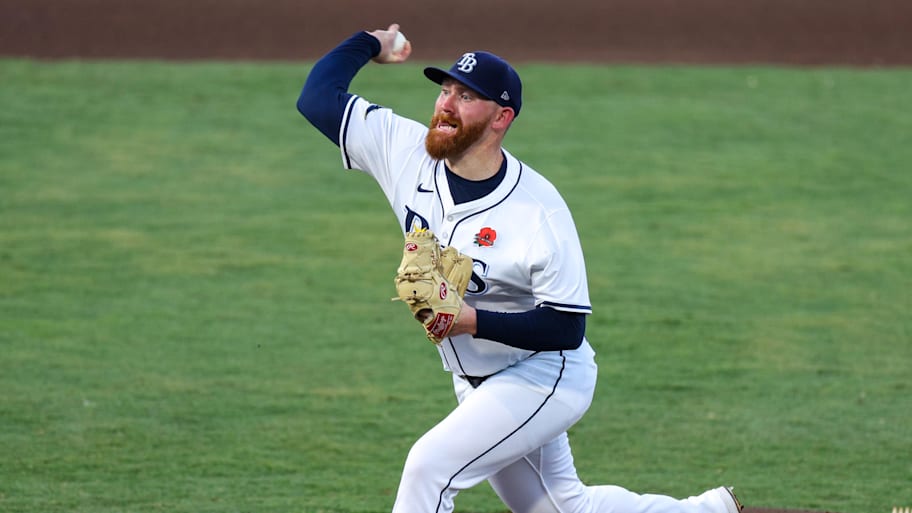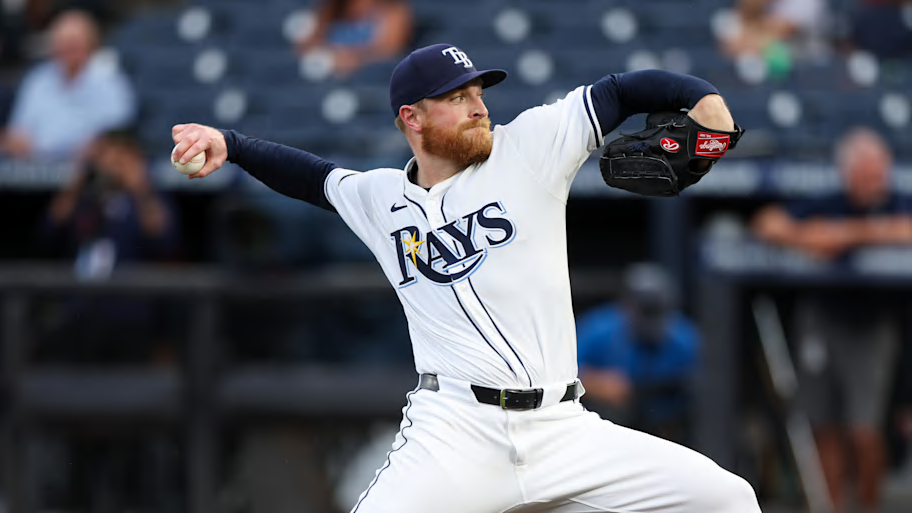On Wednesday, Boston Red Sox outfielder Roman Anthony—the game’s consensus No. 1 prospect—lined a double down the left field line for his first big-league hit. It gave Boston a 2–0 lead in the first inning and created an inauspicious start for Tampa Bay Rays starter Ryan Pepiot.
Pepiot settled in from there, allowing just one more run the rest of the way over 5 2/3 effective innings, but Anthony’s base hit proved to be the difference in a 3–1 defeat. On a micro level, the day was a disappointing one. But from a zoomed out perspective, it was yet another positive step for a Rays pitching staff that has gained steam by bucking the franchise’s typical new-age roster management tendencies.
If they weren’t the inventors of it, the Rays can certainly be credited with popularizing the use of openers. For years, Tampa Bay has sought advantages by churning pitchers in and out of the bullpen and de-emphasizing the traditional five-man starting rotation, often utilizing bullpen games to cover huge swaths of innings. From 2018 to ‘24, Rays starting pitchers ranked no higher than 19th in innings pitched, twice ranking dead last (in ‘18 and ‘22). Last season, Rays starters ranked 23rd in innings and 26th in quality starts.
Through the first two-plus months of 2025, though, the script has completely flipped.
The Rays, somewhat astonishingly, lead the majors in starting pitcher innings so far. Five pitchers—Pepiot, Drew Rasmussen, Zack Littell, Taj Bradley and Shane Baz—have combined to start 67 of Tampa Bay’s 68 games this season (Joe Boyle pitched the other). Only the Los Angeles Angels have used fewer starting pitchers, and only the Philadelphia Phillies have thrown more quality starts.
That level of consistency doesn’t just set Tampa Bay apart from the rest of the league in 2025; it completely upends the way the organization has approached pitching for the better part of a decade.
From 2018 to ‘24, the Rays logged the fifth-most wins in the league and made the postseason six times. During that span, only five out of the team’s 107 starting pitchers—Zach Eflin (‘23), Shane McClanahan (‘22), Corey Kluber (‘22), Charlie Morton (‘19) and Blake Snell (‘18)—logged enough innings to qualify for the ERA title. To date, all five of the Rays’ current starters meet that threshold.
The extreme shift in pitcher usage comes as a result of a few different factors. Understanding how we got here becomes clearer after taking a look at how each of the Tampa Bay Five arrived at this point in their respective careers.

Let’s start with Rasmussen, who underwent two Tommy John surgeries before the Milwaukee Brewers drafted him in the sixth round in 2018. He debuted for Milwaukee in ‘20 and pitched almost exclusively in relief before being traded to the Rays in the Willy Adames deal. Tampa Bay made him a starter, and the righthander thrived in his new role, posting a 2.84 ERA over 146 innings in ‘22.
A strained forearm cost him most of the 2023 and ‘24 seasons, though he’s made his way back to full strength this year and picked up right where he left off, putting up a 2.29 ERA in 13 starts. He has pitched into the fifth inning each time out and made it through six frames in four of his last five games, allowing just two runs during that stretch. For Rasmussen to evolve into an every-fifth-day ace, it has been all about staying healthy and bulking up to the point where he can withstand logging this many innings.
Pepiot’s situation is one of opportunity. The righthander languished in the Los Angeles Dodgers’ minor league system for four years before finally cracking the big league roster in 2023. He never got a bigger role than as a swingman, though, and was traded to Tampa as part of the return for Tyler Glasnow. The Rays slotted him right into their rotation, and he immediately thrived, logging a 3.60 ERA over 130 innings last season. After an up-and-down start to ‘25, he has a 2.49 ERA over his last seven starts, pitching into the sixth in all seven.
Littell was in his sixth MLB season when he landed with the Rays in May 2023 as a waiver claim after the Red Sox designated him for assignment. At that point, he was your prototypical journeyman reliever: Tampa Bay was Littell’s seventh different organization. All but four of his 147 career appearances prior to arriving in St. Petersburg came in relief.
The Rays, though, saw something in Llittell that others didn’t. They tinkered with his pitch mix, adding a splitter and stretching him out into a starting pitcher by the end of the 2023 campaign. The experiment drastically changed his career: He made a team-high 29 starts last season, and last month threw the first complete game for the Rays in nearly four years—yet another sign that times are changing in Tampa.
In Bradley and Baz, the Rays have two young arms who were nurtured in their minor league system. Tampa Bay drafted Bradley in the fifth round in 2018 when he was just 17. By ‘22, he made it to Triple A, and made his big-league debut the following season. Baz was similarly a prospect darling ever since the Pittsburgh Pirates selected him with the 12th pick in the ‘17 draft and subsequently traded him to the Rays (oddly enough, also in a deal involving Glasnow). Both were the franchise’s representatives in the Futures Game (Baz in ‘21 and Bradley in ‘22), and while each has had ups and downs in the big leagues, their potential has been on full display frequently enough that the organization has trusted them to take the ball on a regular cadence.
Holistically, the group represents everything the Rays do so well. They took other organizations' afterthoughts and castoffs—Rasmussen, Pepiot and Littlell—and turned them into key contributors. They developed high upside (and, crucially for the always low-budget Rays, cost-controlled) arms in Bradley and Baz, building them up gradually to get them ready for bulk innings.
Add it all up, and it’s a formidable five-man rotation that has logged heavy innings to keep a dynamic bullpen fresh and put up a respectable 3.74 ERA—all while making less than $13 million combined in 2025.
In some ways, a five-man rotation that never changes is as antiquated as sacrifice bunts and pitchers hitting for themselves. Heck, it’s downright anti-Raysian. But the way Tampa Bay assembled this group and is leaning on it as a strength is simply a continuation of what’s made the Rays the model small-market franchise of the 21st century.
More MLB on Sports Illustrated
This article was originally published on www.si.com as MLB’s Trend Setters Are Going Retro With Their Rotation.
